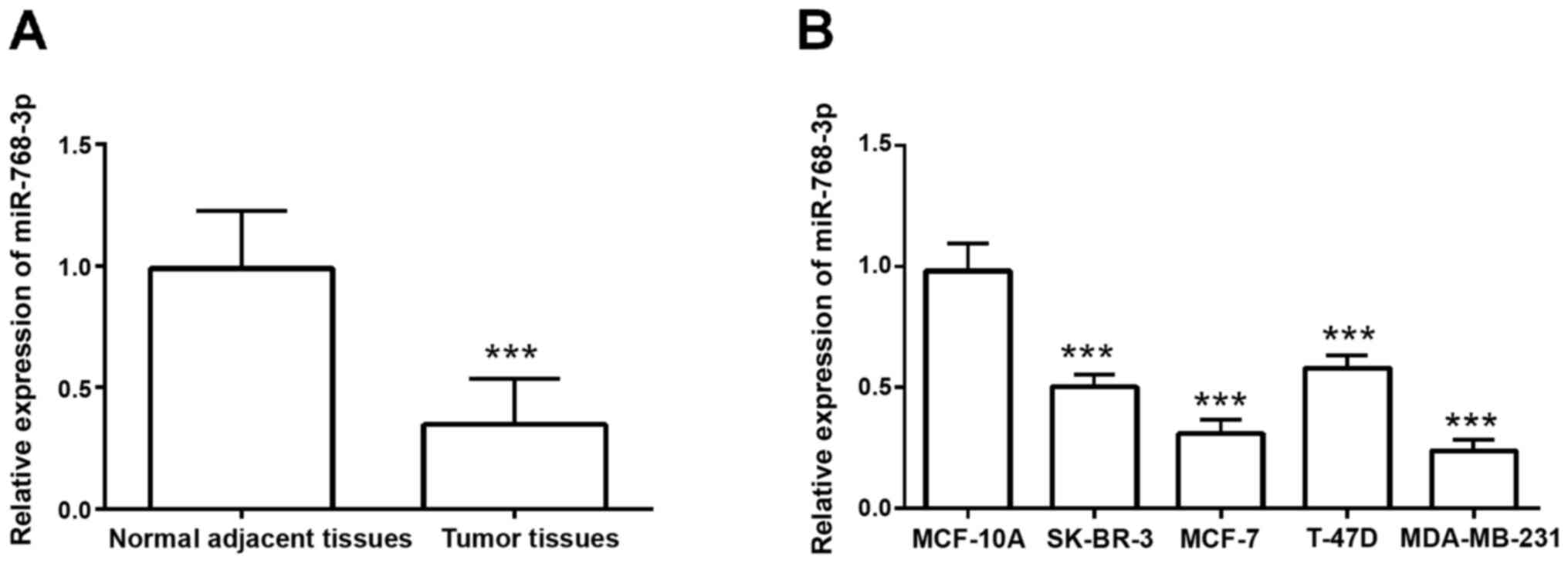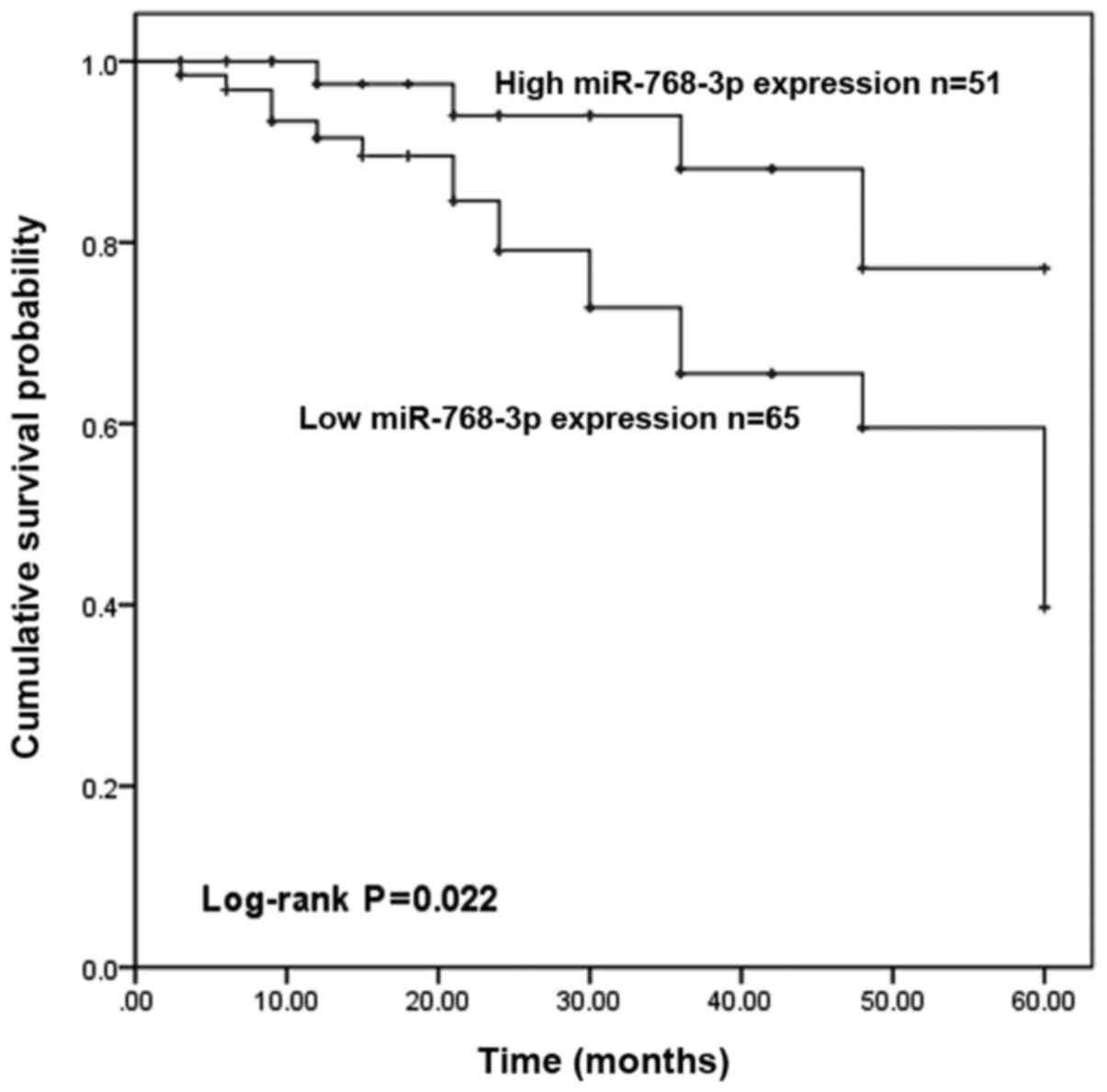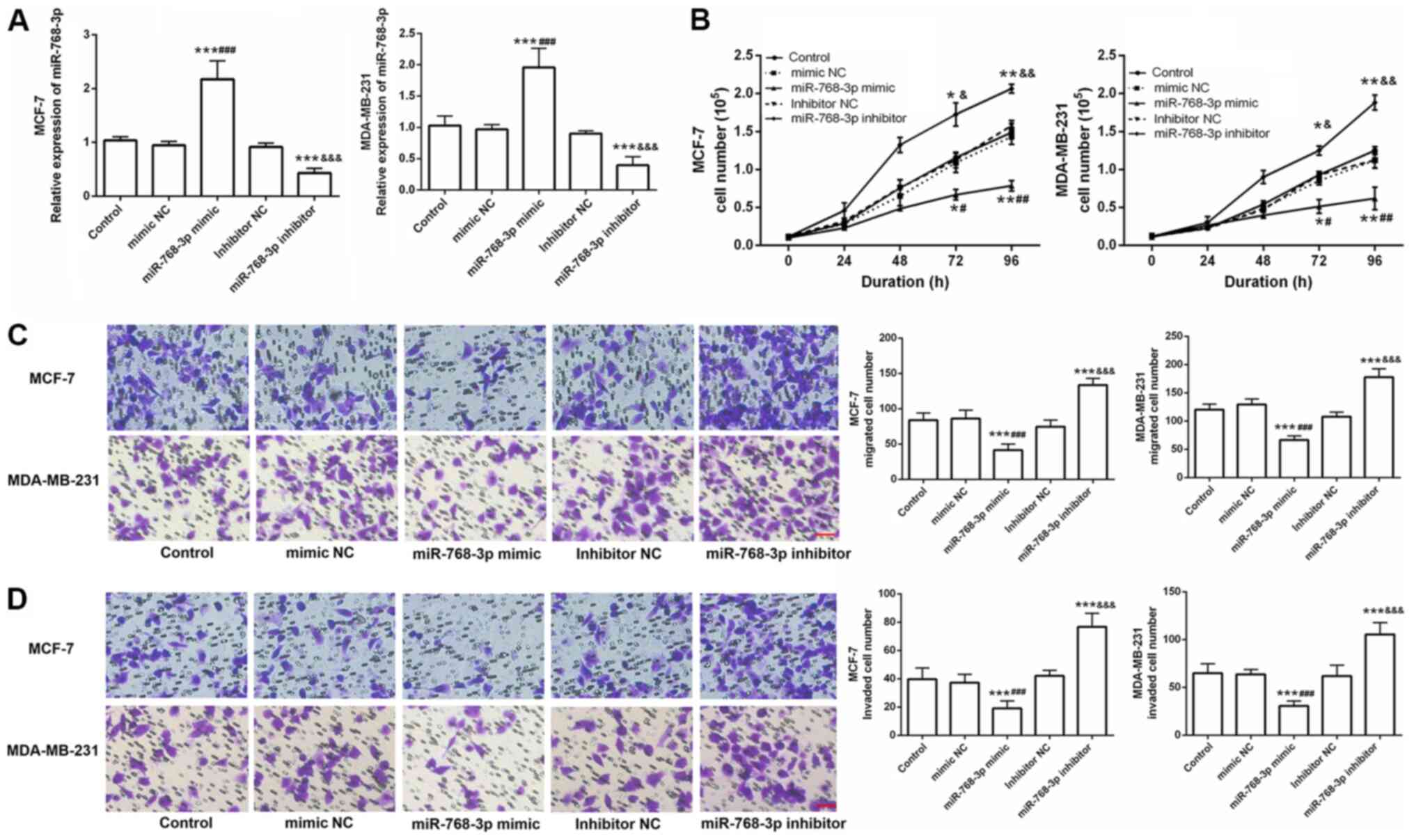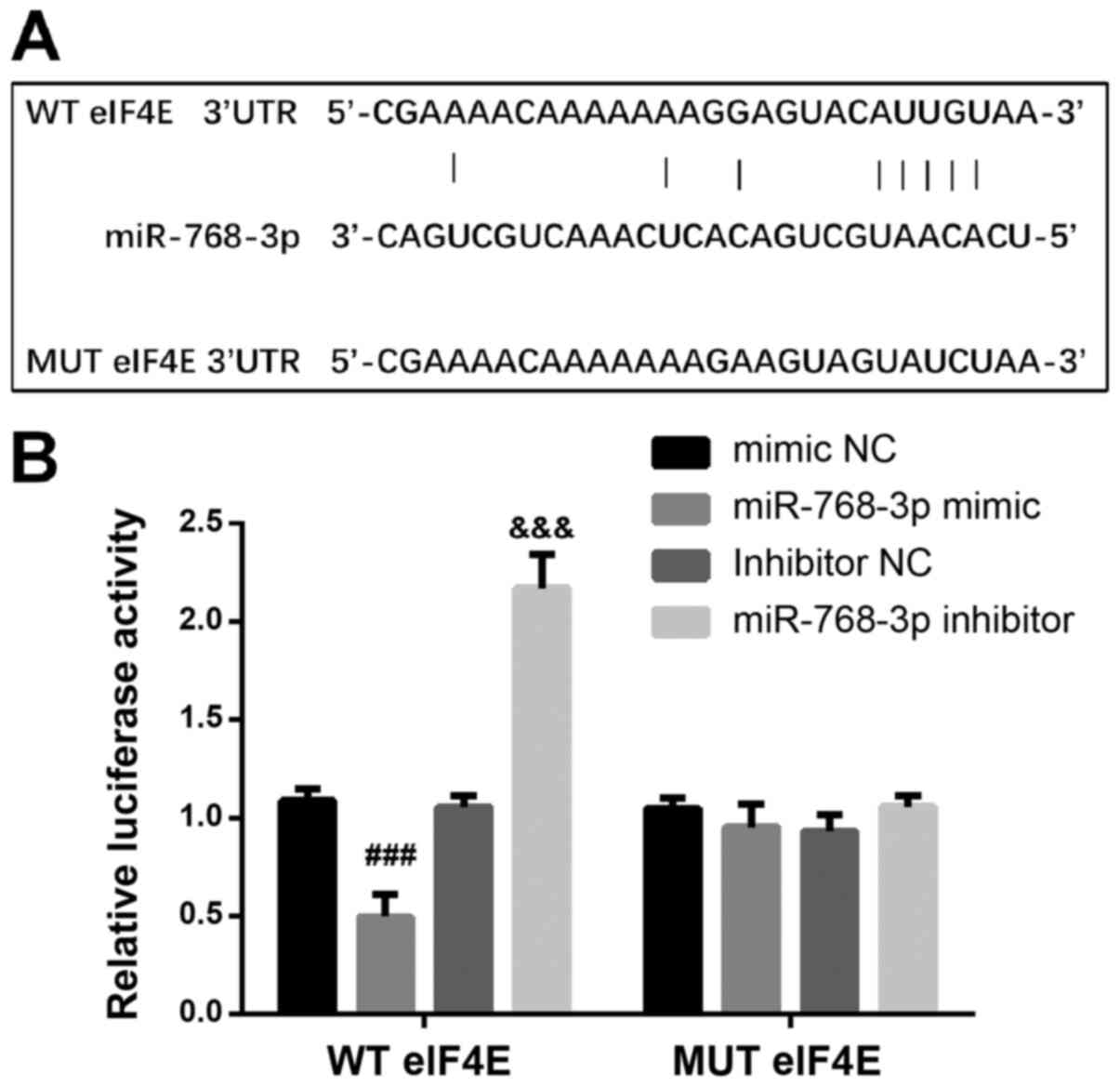|
1
|
Guo R, Chen Y, Borgard H, Jijiwa M, Nasu
M, He M and Deng Y: The function and mechanism of lipid molecules
and their roles in the diagnosis and prognosis of breast cancer.
Molecules. 25:48642020. View Article : Google Scholar : PubMed/NCBI
|
|
2
|
Gu Y, Wu G, Zou X, Huang P and Yi L:
Prognostic value of site-specific metastases and surgery in de novo
stage IV triple-negative breast cancer: A population-based
analysis. Med Sci Monit. 26:e9204322020. View Article : Google Scholar : PubMed/NCBI
|
|
3
|
Wang M, Ji S, Shao G, Zhang J, Zhao K,
Wang Z and Wu A: Effect of exosome biomarkers for diagnosis and
prognosis of breast cancer patients. Clin Transl Oncol. 20:906–911.
2018. View Article : Google Scholar : PubMed/NCBI
|
|
4
|
Li RH, Chen M, Liu J, Shao CC, Guo CP, Wei
XL, Li YC, Huang WH and Zhang GJ: Long noncoding RNA ATB promotes
the epithelial-mesenchymal transition by upregulating the
miR-200c/Twist1 axe and predicts poor prognosis in breast cancer.
Cell Death Dis. 9:11712018. View Article : Google Scholar : PubMed/NCBI
|
|
5
|
Su M, Niu Y, Dang Q, Qu J, Zhu D, Tang Z
and Gou D: Circulating microRNA profiles based on direct
S-Poly(T)Plus assay for detection of coronary heart disease. J Cell
Mol Med. 24:5984–5997. 2020. View Article : Google Scholar : PubMed/NCBI
|
|
6
|
Xiao Y, Humphries B, Yang C and Wang Z:
miR-205 dysregulations in breast cancer: The Complexity and
Opportunities. Noncoding RNA. 5:532019.PubMed/NCBI
|
|
7
|
Chong ZX, Yeap SK and Ho WY: Dysregulation
of miR-638 in the progression of cancers. Pathol Res Pract. Jan
29–2021.(Online ahead of print). View Article : Google Scholar
|
|
8
|
Cai H, Lin H, Cao W, Sun J, Huang Y and
Fang Y: Downregulation of miR-519a predicts poor prognosis and
contributes to tumor progression in gastric cancer. Oncol Res
Treat. 43:19–26. 2020. View Article : Google Scholar : PubMed/NCBI
|
|
9
|
Peng P, Chen T, Wang Q, Zhang Y, Zheng F,
Huang S, Tang Y, Yang C, Ding W, Ren D, et al: Decreased miR-218-5p
levels as a serum biomarker in bone metastasis of prostate cancer.
Oncol Res Treat. 42:165–185. 2019. View Article : Google Scholar : PubMed/NCBI
|
|
10
|
Zhou J, Yu L, Gao X, Hu J, Wang J, Dai Z,
Wang JF, Zhang Z, Lu S, Huang X, et al: Plasma microRNA panel to
diagnose hepatitis B virus-related hepatocellular carcinoma. J Clin
Oncol. 29:4781–4788. 2011. View Article : Google Scholar : PubMed/NCBI
|
|
11
|
Petric R, Gazic B, Goricar K, Dolzan V,
Dzodic R and Besic N: Expression of miRNA and occurrence of distant
metastases in patients with hurthle cell carcinoma. Int J
Endocrinol. 2016:89452472016. View Article : Google Scholar : PubMed/NCBI
|
|
12
|
Xie Z, Chen W, Chen Y, Wang X, Gao W and
Liu Y: miR-768-3p is involved in the viability, invasion and
migration of non-small cell lung carcinomas. Int J Oncol.
51:1574–1582. 2017. View Article : Google Scholar : PubMed/NCBI
|
|
13
|
Guo J, Miao Y, Xiao B, Huan R, Jiang Z,
Meng D and Wang Y: Differential expression of microRNA species in
human gastric cancer versus non-tumorous tissues. J Gastroenterol
Hepatol. 24:652–657. 2009. View Article : Google Scholar : PubMed/NCBI
|
|
14
|
Zheng T, Zhang X, Wang Y and Yu X:
Predicting associations between microRNAs and target genes in
breast cancer by bioinformatics analyses. Oncol Lett. 12:1067–1073.
2016. View Article : Google Scholar : PubMed/NCBI
|
|
15
|
Edge SB and Compton CC: The American Joint
Committee on Cancer: The 7th edition of the AJCC cancer staging
manual and the future of TNM. Ann Surg Oncol. 17:1471–1474. 2010.
View Article : Google Scholar : PubMed/NCBI
|
|
16
|
Livak KJ and Schmittgen TD: Analysis of
relative gene expression data using real-time quantitative PCR and
the 2(-Delta Delta C(T)) method. Methods. 25:402–408. 2001.
View Article : Google Scholar : PubMed/NCBI
|
|
17
|
Zhang P, Fan C, Du J, Mo X and Zhao Q:
Association of miR-1247-5p expression with clinicopathological
parameters and prognosis in breast cancer. Int J Exp Pathol.
99:199–205. 2018. View Article : Google Scholar : PubMed/NCBI
|
|
18
|
Fahad Ullah M: Breast cancer: Current
perspectives on the disease status. Adv Exp Med Biol. 1152:51–64.
2019. View Article : Google Scholar : PubMed/NCBI
|
|
19
|
Berry DA, Cronin KA, Plevritis SK, Fryback
DG, Clarke L, Zelen M, Mandelblatt JS, Yakovlev AY, Habbema JD and
Feuer EJ; Cancer Intervention and Surveillance Modeling Network
(CISNET) Collaborators, : Effect of screening and adjuvant therapy
on mortality from breast cancer. N Engl J Med. 353:1784–1792. 2005.
View Article : Google Scholar : PubMed/NCBI
|
|
20
|
Foulkes WD, Smith IE and Reis-Filho JS:
Triple-negative breast cancer. N Engl J Med. 363:1938–1948. 2010.
View Article : Google Scholar : PubMed/NCBI
|
|
21
|
Zhou W, Gong J, Chen Y, Chen J, Zhuang Q,
Cao J, Mei Z and Hu B: Long noncoding RNA LINC00899 suppresses
breast cancer progression by inhibiting miR-425. Aging (Albany NY).
11:10144–10153. 2019. View Article : Google Scholar : PubMed/NCBI
|
|
22
|
Rahman MM, Brane AC and Tollefsbol TO:
MicroRNAs and epigenetics strategies to reverse breast cancer.
Cells. 8:12142019. View Article : Google Scholar : PubMed/NCBI
|
|
23
|
Weng YS, Tseng HY, Chen YA, Shen PC, Al
Haq AT, Chen LM, Tung YC and Hsu HL: MCT-1/miR-34a/IL-6/IL-6R
signaling axis promotes EMT progression, cancer stemness and M2
macrophage polarization in triple-negative breast cancer. Mol
Cancer. 18:422019. View Article : Google Scholar : PubMed/NCBI
|
|
24
|
Fang H, Jiang W, Jing Z, Mu X and Xiong Z:
miR-937 regulates the viability and apoptosis via targeting APAF1
in breast cancer. Onco Targets Ther. 12:5687–5699. 2019. View Article : Google Scholar : PubMed/NCBI
|
|
25
|
Li F: Expression of miR-221 and miR-489 in
breast cancer patients and their relationship with prognosis. Oncol
Lett. 19:1523–1529. 2020.PubMed/NCBI
|
|
26
|
Sun R, Muheremu A and Hu Y: miRNA-30c can
be used as a target in the diagnosis and treatment of osteosarcoma.
Onco Targets Ther. 11:9091–9099. 2018. View Article : Google Scholar : PubMed/NCBI
|
|
27
|
Wang F, Dai M, Chen H, Li Y, Zhang J, Zou
Z and Yang H: Prognostic value of hsa-mir-299 and hsa-mir-7706 in
hepatocellular carcinoma. Oncol Lett. 16:815–820. 2018.PubMed/NCBI
|
|
28
|
Li C, Zhang J, Ma Z, Zhang F and Yu W:
miR-19b serves as a prognostic biomarker of breast cancer and
promotes tumor progression through PI3K/AKT signaling pathway. Onco
Targets Ther. 11:4087–4095. 2018. View Article : Google Scholar : PubMed/NCBI
|
|
29
|
Quan Y, Huang X and Quan X: Expression of
miRNA-206 and miRNA-145 in breast cancer and correlation with
prognosis. Oncol Lett. 16:6638–6642. 2018.PubMed/NCBI
|
|
30
|
Vriens MR, Weng J, Suh I, Huynh N,
Guerrero MA, Shen WT, Duh QY, Clark OH and Kebebew E: MicroRNA
expression profiling is a potential diagnostic tool for thyroid
cancer. Cancer. 118:3426–3432. 2012. View Article : Google Scholar : PubMed/NCBI
|
|
31
|
Jiang CC, Croft A, Tseng HY, Guo ST, Jin
L, Hersey P and Zhang XD: Repression of microRNA-768-3p by MEK/ERK
signalling contributes to enhanced mRNA translation in human
melanoma. Oncogene. 33:2577–2588. 2014. View Article : Google Scholar : PubMed/NCBI
|
|
32
|
Pisera A, Campo A and Campo S: Structure
and functions of the translation initiation factor eIF4E and its
role in cancer development and treatment. J Genet Genomics.
45:13–24. 2018. View Article : Google Scholar : PubMed/NCBI
|
|
33
|
Ma X, Li B, Liu J, Fu Y and Luo Y:
Phosphoglycerate dehydrogenase promotes pancreatic cancer
development by interacting with eIF4A1 and eIF4E. J Exp Clin Cancer
Res. 38:662019. View Article : Google Scholar : PubMed/NCBI
|
|
34
|
Wu S, Yang L, Wu D, Gao Z, Li P, Huang W
and Wang X: AEG-1 induces gastric cancer metastasis by upregulation
of eIF4E expression. J Cell Mol Med. 21:3481–3493. 2017. View Article : Google Scholar : PubMed/NCBI
|
|
35
|
Jin J, Xiang W, Wu S, Wang M, Xiao M and
Deng A: Targeting eIF4E signaling with ribavirin as a sensitizing
strategy for ovarian cancer. Biochem Biophys Res Commun.
510:580–586. 2019. View Article : Google Scholar : PubMed/NCBI
|
|
36
|
Zhao Y, Yan M, Yun Y, Zhang J, Zhang R, Li
Y, Wu X, Liu Q, Miao W and Jiang H: MicroRNA-455-3p functions as a
tumor suppressor by targeting eIF4E in prostate cancer. Oncol Rep.
37:2449–2458. 2017. View Article : Google Scholar : PubMed/NCBI
|
|
37
|
Liu F, Wang X, Li J, Gu K, Lv L, Zhang S,
Che D, Cao J, Jin S and Yu Y: miR-34c-3p functions as a tumour
suppressor by inhibiting eIF4E expression in non-small cell lung
cancer. Cell Prolif. 48:582–592. 2015. View Article : Google Scholar : PubMed/NCBI
|
|
38
|
Karaki S, Andrieu C, Ziouziou H and Rocchi
P: The eukaryotic translation initiation Factor 4E (eIF4E) as a
therapeutic target for cancer. Adv Protein Chem Struct Biol.
101:1–26. 2015. View Article : Google Scholar : PubMed/NCBI
|
|
39
|
Sobocan M, Smolle MA, Schatz C and
Haybaeck J: The interplay of tumor stroma and translational factors
in endometrial cancer. Cancers (Basel). 12:20742020. View Article : Google Scholar : PubMed/NCBI
|


















